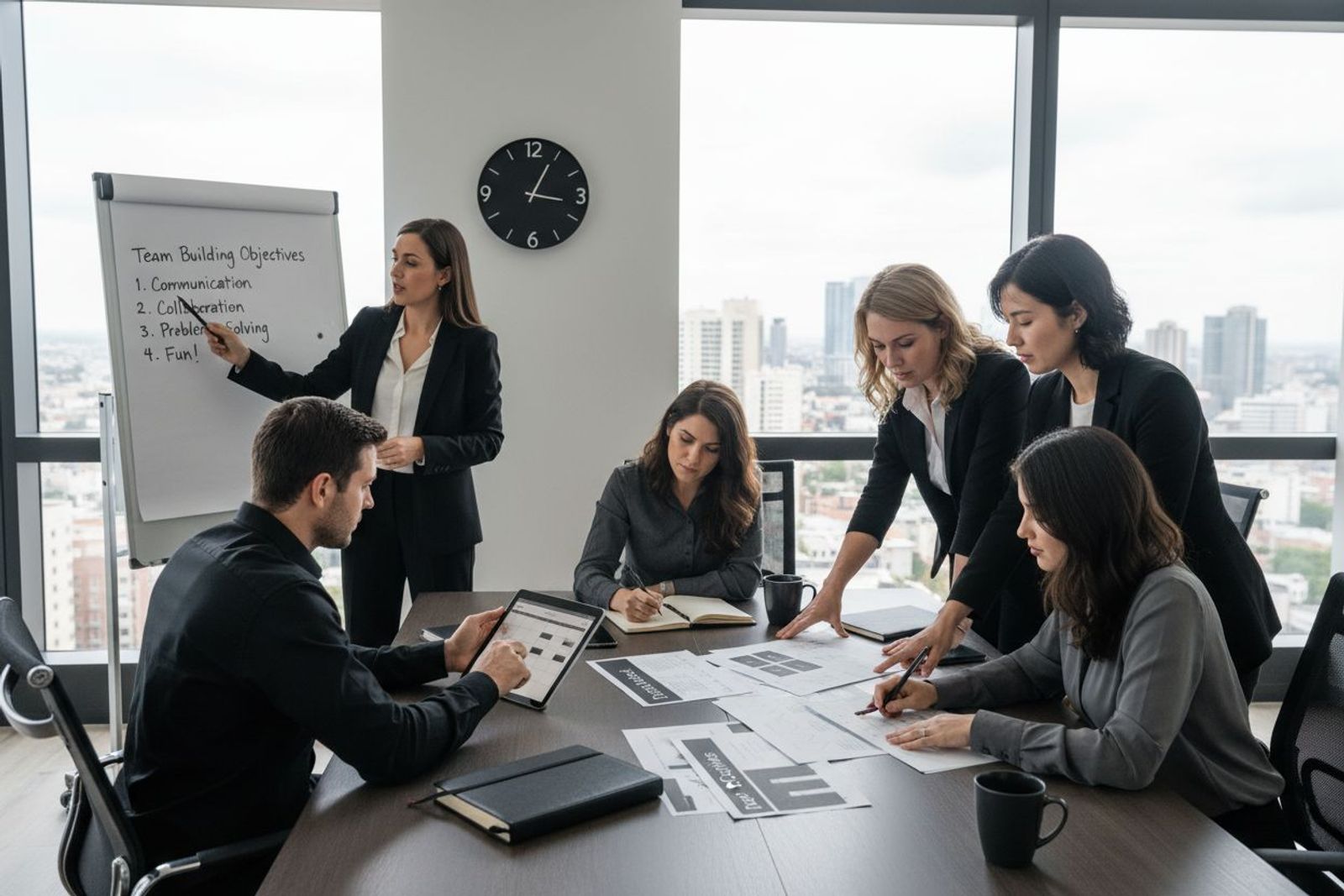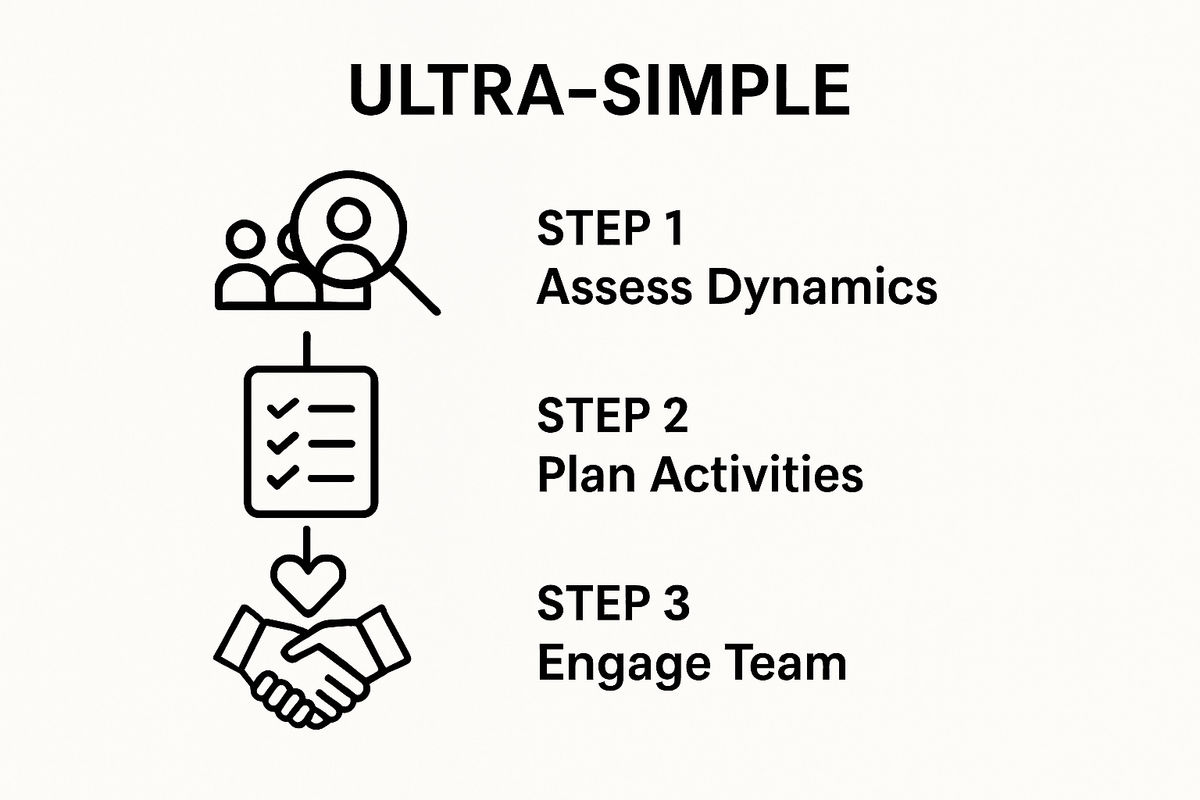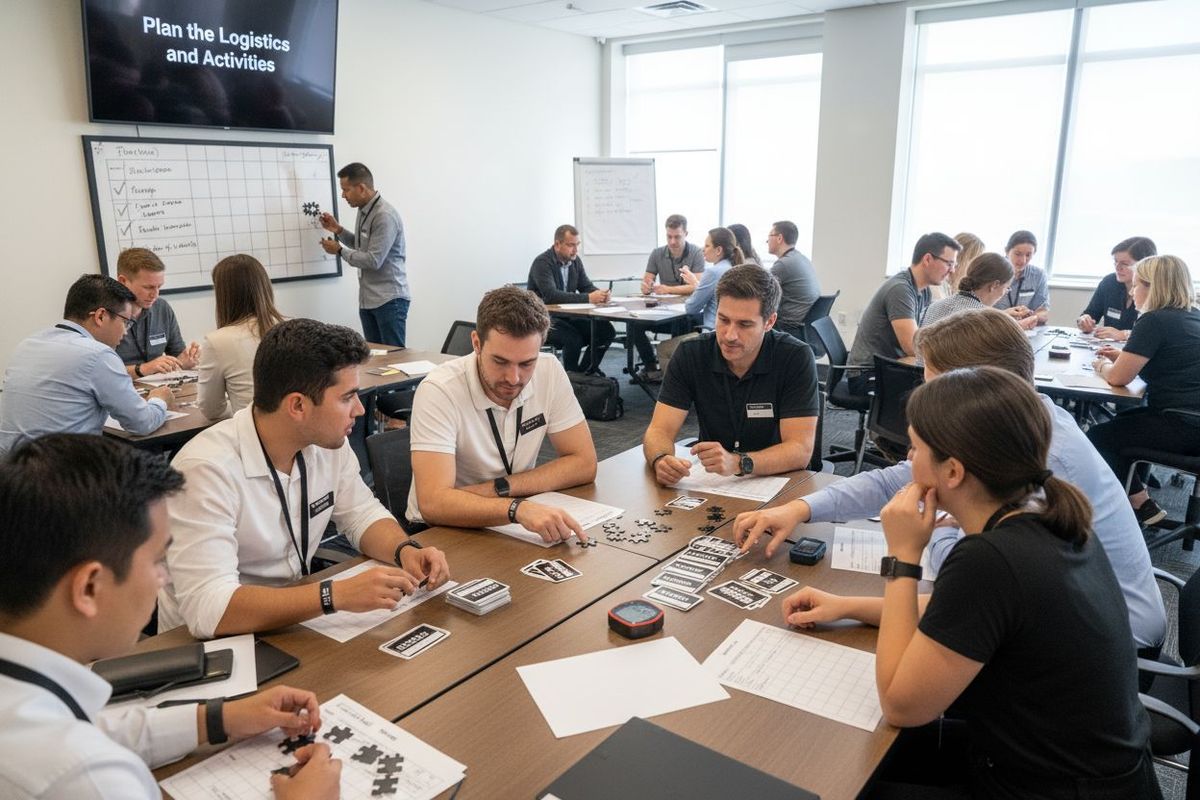How to Organize Team Building Event for Boosting Team Spirit
October 1, 2025

Planning team building events can feel overwhelming and sometimes looks more like herding cats than fostering connection. Yet research shows that proactive communication strategies can boost participant buy-in and overall event effectiveness. Most people think the secret is a few fun games or a nice venue, but the real power comes from aligning every detail with your actual team objectives and preferences. There is way more science to this than anyone expects.
Table of Contents
- Step 1: Define Your Team Building Objectives
- Step 2: Assess Team Dynamics and Preferences
- Step 3: Plan The Logistics and Activities
- Step 4: Communicate Details and Encourage Participation
- Step 5: Execute The Event and Engage Participants
- Step 6: Gather Feedback and Evaluate Outcomes
Quick Summary
| Key Point | Explanation |
|---|---|
| 1. Define clear team objectives. | Set specific, measurable goals to guide team building activities for effective outcomes. |
| 2. Assess team dynamics thoroughly. | Understand individual preferences and interpersonal interactions to create a tailored experience. |
| 3. Plan engaging and relevant activities. | Choose diverse activities that align with objectives and accommodate all team members' preferences. |
| 4. Communicate effectively about the event. | Use multiple channels to highlight the event's purpose and foster excitement among participants. |
| 5. Gather feedback for continuous improvement. | Collect multi-dimensional feedback to evaluate event impact and inform future team development strategies. |
Step 1: Define your Team Building Objectives
Defining clear and strategic objectives is the critical foundation for any successful team building event. Without precise goals, your activity risks becoming a disconnected social gathering rather than a meaningful organizational experience. Team building objectives serve as your navigational compass, guiding every subsequent decision about event design, participant engagement, and desired outcomes.
Begin by conducting a focused assessment of your current team dynamics and organizational needs. This means carefully examining areas where collaboration, communication, or mutual understanding might be lacking. Are team members struggling with interdepartmental communication? Do recent project challenges reveal gaps in problem solving skills? Understanding these nuanced organizational challenges will help you craft objectives that directly address real workplace requirements.
Your objectives should be specific, measurable, and aligned with broader organizational goals. For instance, instead of a vague aim like "improve teamwork," consider more precise targets such as "enhance cross functional communication by 25%" or "develop collaborative problem solving skills through interactive scenarios." This precision transforms team building from a generic social event into a strategic professional development opportunity.
When developing these objectives, involve key stakeholders from different organizational levels. HR representatives, department managers, and team leaders can provide valuable insights into current team challenges and potential growth areas. Check out our comprehensive guide on team dynamics for deeper strategies in understanding organizational collaboration patterns.
Essential considerations for defining team building objectives should include:
- Identifying specific skill gaps or communication barriers
- Aligning activities with current organizational challenges
- Creating measurable outcomes for participant engagement
- Ensuring objectives support broader company cultural values
Remember that well defined objectives transform team building from a mundane mandatory activity into a powerful tool for organizational growth and team cohesion. Your careful planning at this initial stage sets the groundwork for a transformative team building experience that resonates far beyond a single event.
The following table summarizes the key phases of organizing a successful team building event, including main activities, approximate focus, and intended outcomes for each step.
| Step | Main Activity | Primary Focus | Expected Outcome |
|---|---|---|---|
| 1 | Define Objectives | Align with company goals | Clarity on desired results |
| 2 | Assess Team Dynamics | Survey and observe teams | Tailored experience design |
| 3 | Plan Logistics & Activities | Choose venue, schedule, activities | Seamless and inclusive event |
| 4 | Communicate Details | Inform and engage participants | Increased buy-in and anticipation |
| 5 | Execute Event | Facilitate and adapt in real-time | Active engagement and collaboration |
| 6 | Gather Feedback & Evaluate | Collect and analyze feedback | Insight for future improvements |
Step 2: Assess Team Dynamics and Preferences
Successful team building begins with a nuanced understanding of your team's unique composition, communication patterns, and underlying interpersonal dynamics. This critical assessment phase goes far beyond superficial observations, requiring a strategic and empathetic approach to uncovering the complex interactions that define your organizational ecosystem. Learn more about team collaboration strategies to enhance your understanding.
Start by conducting a comprehensive survey that explores individual preferences, communication styles, and comfort levels with different types of group activities. This survey should be designed to capture both professional insights and personal perspectives, allowing team members to share their genuine thoughts anonymously. Questions might explore comfort with public speaking, preference for competitive versus collaborative tasks, physical activity tolerance, and individual learning styles. The goal is to create a holistic profile that reveals not just professional capabilities but also personal engagement preferences.
Pay special attention to the diverse personality types within your team. Some individuals thrive in high energy, competitive environments, while others prefer more reflective, collaborative experiences. Recognizing and respecting these differences is crucial for designing an inclusive team building event that genuinely connects and energizes all participants. Consider utilizing established personality assessment tools like Myers Briggs or DiSC profiling to gain deeper insights into team member characteristics and potential interaction dynamics.
Key areas to explore during your team dynamics assessment include:
- Communication preferences and styles
- Comfort levels with different activity types
- Individual strengths and potential collaboration challenges
- Personal and professional development goals
By meticulously mapping your team's unique characteristics, you transform team building from a generic group activity into a targeted, meaningful experience that resonates with each participant's individual needs and organizational aspirations. Your thorough assessment becomes the strategic blueprint for a truly transformative team building event.
Step 3: Plan the Logistics and Activities
Planning the logistics and activities represents the critical execution phase where your strategic team building objectives transform into tangible experiences. This step requires meticulous attention to detail, balancing organizational goals with participant preferences discovered during your team dynamics assessment. The key is creating an engaging framework that feels both purposeful and enjoyable.
Begin by selecting activities that directly align with your previously defined objectives while respecting the diverse preferences uncovered in your team assessment. This means crafting a balanced event that incorporates different interaction styles, physical engagement levels, and collaborative approaches. For instance, if your assessment revealed a team with mixed communication styles, design activities that provide multiple participation pathways—some that require verbal interaction, others that emphasize problem solving, and some that allow more introspective contributions.
Explore our comprehensive guide on customizing team games to understand innovative approaches to activity selection. Consider activities that create genuine opportunities for cross functional interaction, skill demonstration, and collective problem solving. These might include scenario based challenges, collaborative puzzle solving, strategic simulation exercises, or integrated team competitions that require multiple skill sets and perspectives to successfully complete.
Practical logistical considerations are equally important in event planning. Carefully evaluate venue selection, timing, duration, budget constraints, and potential accessibility requirements. Choose locations that provide appropriate space for planned activities, considering factors like room layout, technological needs, and comfort of participants. Ensure the selected venue supports the specific dynamics of your chosen team building exercises while providing a comfortable, engaging environment.
Critical logistical elements to meticulously plan include:

- Precise activity scheduling and time allocation
- Comprehensive resource and equipment requirements
- Backup plans for potential scheduling or participation challenges
- Clear communication protocols for participants
- Accessibility and comfort considerations for all team members
Remember that successful team building is not about perfection but about creating meaningful shared experiences that foster genuine connection, mutual understanding, and collective growth. Your careful planning transforms a potentially mundane corporate event into a powerful catalyst for team cohesion and organizational development.

Step 4: Communicate Details and Encourage Participation
Effective communication is the linchpin of successful team building, transforming a potentially mundane event into an anticipated and engaging organizational experience. This step is about creating anticipation, transparency, and genuine excitement that motivates every team member to not just attend, but actively participate with enthusiasm. According to research on organizational engagement, proactive communication significantly increases participant buy-in and overall event effectiveness.
Crafting a comprehensive communication strategy requires a multi-channel approach that speaks to different communication preferences and learning styles. Begin by developing a clear, compelling narrative around the team building event that connects directly to the objectives established in earlier planning stages. This means moving beyond generic announcements to create a meaningful context that demonstrates the event's value to individual team members and the broader organizational ecosystem.
Utilize diverse communication channels to ensure maximum reach and engagement. This might include personalized email invitations, brief video teasers, interactive digital platforms, and direct team leader communication. Each communication touchpoint should emphasize not just the logistical details, but the potential personal and professional benefits of participation. Highlight how the event aligns with individual growth opportunities, team development goals, and broader organizational strategies.
Encouraging authentic participation goes beyond simple information sharing. Create opportunities for team members to provide input, ask questions, and express potential concerns about the upcoming event. This might involve hosting brief pre-event information sessions, establishing dedicated communication channels for event related queries, or developing an anonymous feedback mechanism that allows team members to share their expectations and potential reservations.
Key communication strategies to implement include:
- Personalized, multi-channel event communication
- Clear articulation of event purpose and potential benefits
- Opportunities for two way dialogue and participant input
- Transparent information about event logistics and expectations
- Mechanisms for addressing individual concerns or questions
Remember that successful communication is not about overwhelming participants with information, but about creating a compelling narrative that transforms team building from a mandatory corporate activity into an anticipated opportunity for genuine connection and collective growth. Your strategic communication approach sets the foundation for an engaging, meaningful team experience.
Step 5: Execute the Event and Engage Participants
Event execution represents the critical moment where months of strategic planning converge into a live, dynamic experience that can genuinely transform team dynamics. Successful implementation requires a delicate balance of structured facilitation and organic interaction, ensuring that predetermined objectives seamlessly blend with authentic participant engagement. Explore our insights on team game customization to enhance your event execution strategy.
Prepare for real time adaptation by assembling a skilled facilitation team capable of reading the room's energy and making instantaneous adjustments. This means having backup activity options, understanding how to pivot if an exercise is not resonating, and maintaining a fluid, responsive approach to participant interaction. Experienced facilitators recognize that rigid adherence to a predetermined script can undermine the event's potential for genuine connection and learning.
Create an environment that prioritizes psychological safety, allowing participants to engage without fear of judgment or professional repercussion. This involves establishing clear ground rules that encourage open communication, respect diverse perspectives, and promote collaborative problem solving. Facilitators should model these principles through their own behavior, demonstrating active listening, empathy, and a genuine commitment to collective growth.
During the event, focus on deliberately creating moments of meaningful interaction that go beyond surface level engagement. Design activities that require interdependent participation, where success depends on genuine communication, mutual understanding, and collective effort. These experiences should challenge participants to step outside their typical workplace roles, revealing new dimensions of individual and collective capabilities.
Critical execution considerations include:
- Maintaining flexible, responsive facilitation strategies
- Creating psychologically safe interaction environments
- Designing activities that promote genuine collaboration
- Monitoring participant energy and engagement levels
- Ensuring inclusive participation across diverse team member profiles
Remember that the most powerful team building experiences are not about perfect execution but about creating authentic opportunities for connection, mutual understanding, and collective growth. Your strategic approach transforms a potentially mundane corporate event into a transformative organizational experience that resonates far beyond the immediate activity.
Step 6: Gather Feedback and Evaluate Outcomes
Feedback collection and outcome evaluation represent the critical reflective phase that transforms a team building event from a standalone experience into a strategic organizational development tool. This step is not merely about collecting data, but about creating a comprehensive understanding of the event's impact on team dynamics, individual perceptions, and organizational objectives. Learn more about building team cohesion strategies to enhance your evaluation approach.
Design a multi dimensional feedback mechanism that captures both quantitative and qualitative insights. This means developing surveys and assessment tools that go beyond surface level satisfaction ratings, delving into nuanced aspects of participant experience, learning outcomes, and potential behavioral shifts. Utilize a combination of anonymous digital surveys, structured interviews, and follow up focus group discussions to gather a comprehensive perspective on the event's effectiveness.
The evaluation process should directly connect back to the original objectives established during the initial planning phase. Compare the predefined goals with actual participant experiences and observable team interaction changes. Look for tangible indicators of improved communication, enhanced collaborative skills, and shifts in interpersonal dynamics. This might involve tracking metrics like increased cross functional collaboration, improved problem solving efficiency, or more constructive conflict resolution approaches in subsequent workplace interactions.
Establish a systematic approach to feedback analysis that allows for both immediate insights and long term organizational learning. Create mechanisms for tracking team performance and interaction patterns in the weeks and months following the team building event. This longitudinal perspective provides a more comprehensive understanding of the event's true impact, moving beyond immediate reactions to genuine transformational outcomes.
Critical feedback and evaluation strategies include:
- Developing comprehensive, multi method feedback collection tools
- Connecting evaluation metrics to original event objectives
- Implementing both immediate and long term assessment approaches
- Creating actionable insights for future organizational development
- Ensuring anonymity and psychological safety in feedback processes
Remember that effective evaluation is not about proving success, but about genuinely understanding the complex dynamics of team development. Your thoughtful, strategic approach to feedback collection transforms the team building event from a singular experience into a continuous learning opportunity for individual team members and the broader organizational ecosystem.
This table outlines commonly used feedback methods mentioned in the article, with descriptions and the unique benefit each approach provides for team building event evaluation.
| Feedback Method | Description | Unique Benefit |
|---|---|---|
| Anonymous Surveys | Collects quantitative and qualitative input after event | Honest responses without fear of judgment |
| Structured Interviews | One-on-one or small group discussions about experiences | Deeper insights into participant perspectives |
| Focus Groups | Group discussions to explore collective feedback | Reveals group dynamics and shared views |
| Digital Assessment Tools | Online forms for quick, multi-faceted feedback | Easy to administer and analyze data |
| Follow-up Performance Tracking | Observing team behavior over time | Measures actual change post-event |
Bring Your Team Building Vision to Life with Custom Quizzes
Struggling to turn team building objectives into truly meaningful and memorable team bonding? If your biggest challenge is creating an inclusive event that blends organizational goals with genuine fun, you're not alone. Many managers want to boost cross-functional communication and encourage open collaboration but find their team disengages with generic activities. You have already learned that unique group dynamics and clear objectives are crucial for lasting impact.

The solution is at your fingertips. With Quizado's interactive quiz platform, you can personalize every element of your next team building event. Craft games inspired by classic shows like Family Feud and Jeopardy to target specific goals such as communication, problem-solving, and engagement. Host online or offline sessions, upload your team’s branding, and enjoy seamless remote control using smartphones. Ready to make your objectives stick and drive real results? Discover how easy it is to create customized team-building games that excite every participant. Take the next step to energize your team and transform company culture—explore Quizado.com now.
Frequently Asked Questions
What are the first steps to organizing a team building event?
Begin by defining clear and strategic objectives that align with your organization's goals. Assess your team's dynamics and preferences to understand their needs. This foundational planning ensures your event is meaningful and relevant.
How can I assess my team's dynamics effectively?
Conduct a survey to explore individual preferences, communication styles, and comfort levels with different activities. This helps create a holistic profile of your team, allowing you to plan activities that resonate with everyone's unique characteristics.
What types of activities should be included in a team building event?
Select activities that align with your objectives and cater to various interaction styles, such as scenario-based challenges, collaborative puzzles, or strategic simulations. Ensure the activities promote cross-functional interaction and require teamwork for success.
How do I gather feedback after the team building event?
Design a multi-dimensional feedback mechanism using surveys and structured interviews to capture participants' experiences and learning outcomes. Analyze this feedback to evaluate the event’s impact on team dynamics and continuous organizational development.



